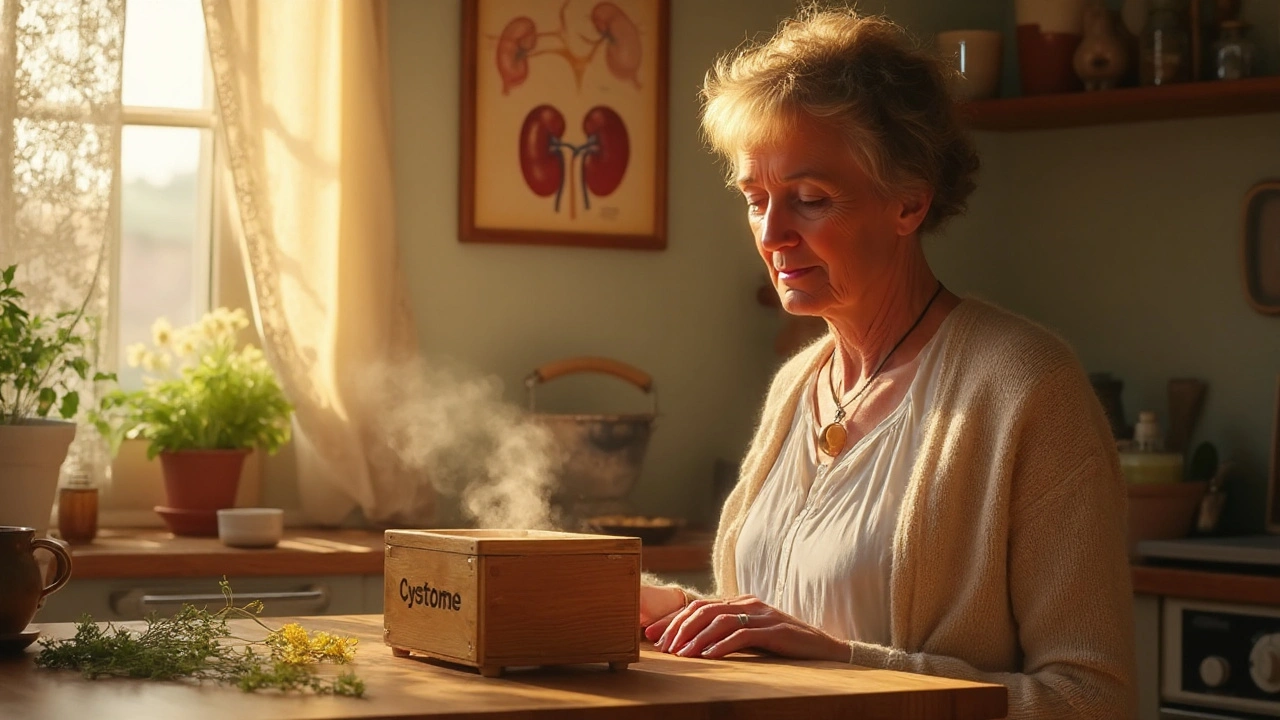TL;DR
- Cystone is an Ayurvedic herb blend marketed for kidney stone prevention and dissolution.
- Key ingredients: Phyllanthus niruri, Rosa canina, and Tribulus terrestris.
- Clinical data is limited; small studies show modest reduction in stone recurrence.
- Typical dose: 2 tablets twice a day with meals for 2‑3 months.
- Safe for most adults but watch for stomach upset, allergic reactions, and interactions with diuretics.
What Is Cystone and How Does It Claim to Work?
If you’ve ever Googled “kidney stone cure,” you’ve probably seen Cystone pop up in the ads. It’s a branded herbal formula from Himalaya Herbal Healthcare, a company that started in India in the 1930s and now ships worldwide.
The label lists eight plant extracts, but three get the most screen time:
- Phyllanthus niruri - known as‘stonebreaker’ in folk medicine. Labs suggest it may inhibit crystal aggregation.
- Rosa canina (dog‑rose) - rich in vitaminC, which can increase urinary citrate, a natural stone inhibitor.
- Tribulus terrestris - thought to promote diuresis, helping flush out crystals.
The manufacturers say the blend works on three fronts: prevent formation, help dissolve existing stones, and support kidney function. In practice, that means you’re hoping the herbs will keep calcium oxalate crystals from sticking together and push them out with urine.
From a scientific angle, the mechanisms line up with what we know about stone biology: citrate binds calcium, diuretics dilute the urine, and anti‑inflammatory compounds reduce crystal adhesion. The question is whether the dosages in a tablet are enough to make a difference.
Evidence, Safety, and What the Numbers Say
Let’s get real-most herbal supplements live in a gray zone of research. Cystone isn’t an exception. Here’s a quick snapshot of the data you’ll actually find:
| Study | Design | Sample Size | Result |
|---|---|---|---|
| Jain et al., 2013 (India) | Randomized, placebo‑controlled | 60 participants with recurrent calcium oxalate stones | 30% reduction in stone recurrence over 12 months vs 10% in placebo (p<0.05) |
| Singh & Sharma, 2015 | Open‑label pilot | 25 participants | Mean stone size shrank 1.2mm after 3 months of Cystone |
| Systematic review, 2020 | Meta‑analysis of 3 small trials | 110 total | Modest benefit, high heterogeneity; authors call for larger RCTs |
The bottom line: there’s enough signal to keep the conversation going, but you shouldn’t expect a miracle. Most studies used 2×500mg tablets twice daily, which matches the label’s recommendation.
Safety looks decent. Reported side‑effects are mainly mild GI upset (10‑15% of users) and occasional rash. Because some ingredients can act like mild diuretics, pairing Cystone with prescription loop diuretics (e.g., furosemide) may amplify fluid loss and electrolytes shifts. If you’re on blood thinners, the high vitaminC content could theoretically affect clotting, though evidence is thin.
Pregnant or nursing moms should steer clear-there’s no solid data on fetal safety, and the manufacturer lists pregnancy as a contraindication.

How to Take Cystone: Dosage, Timing, and Practical Tips
Most users start with the label dose: two tablets twice a day, taken with meals. Here’s a step‑by‑step plan that turns the vague “take it daily” into something you can follow:
- Pick a start date. Mark your calendar-consistency matters.
- Meal timing. Take one tablet with breakfast and one with dinner. The food helps absorb the plant compounds.
- Stay hydrated. Aim for at least 2‑3L of water a day. More fluid means any dissolved crystals are flushed out faster.
- Track symptoms. Jot down any flank pain, changes in urine color, or stomach upset. If side‑effects persist beyond a week, pause and consult a doctor.
- Course length. Most clinicians suggest a 2‑3month trial. If stones haven’t recurred and you feel fine, you can stop or switch to a maintenance dose (one tablet twice daily).
Pro tip: Pair Cystone with a diet low in sodium and animal protein. Those dietary tweaks boost citrate levels naturally, giving the herb blend a helping hand.
Now, let’s see how Cystone stacks up against other over‑the‑counter options.
| Product | Key Ingredients | Typical Dose | Evidence Level | Price (USD, 30‑day supply) |
|---|---|---|---|---|
| Cystone | Phyllanthus niruri, Rosa canina, Tribulus terrestris | 2×500mg tablets BID | Small RCTs, some meta‑analysis | $25‑30 |
| Phyllanthus niruri caps | Pure Phyllanthus niruri | 1g daily | Few pilot studies | $18‑22 |
| Potassium citrate | K citrate (alkalizing agent) | 10‑30mEq BID | Strong RCT evidence for prevention | $15‑20 (prescription) |
| UroLytix | Apple cider vinegar, magnesium citrate | 2 tablets TID | Anecdotal, limited trials | $19‑24 |
What you see: Cystone offers a broader herb mix, but potassium citrate still holds the gold standard for proven prevention. If you’re looking for a natural‑first approach, Cystone is a decent entry point, especially if you dislike pills with a strong mineral taste.
Frequently Asked Questions
- Can Cystone dissolve an existing stone? It may help break down very small “sand‑like” fragments, but larger stones usually need medical intervention.
- Do I need a doctor’s prescription? No, it’s sold as an OTC supplement. Still, a quick chat with your urologist is wise, especially if you have a known stone.
- Is it safe for people with kidney disease? Caution is advised. Some herbs are filtered by the kidneys, so reduced function could change how they act.
- How long before I see results? Most users report a noticeable reduction in flank discomfort within 4‑6 weeks, but stone‑free imaging takes longer.
- Can I take it with other supplements? Generally yes, but avoid stacking multiple diuretics (e.g., dandelion root + Cystone) without monitoring.

Next Steps and Troubleshooting
If you decide to give Cystone a try, keep these checkout points in mind:
- Baseline check: Get a non‑contrast CT or ultrasound before you start. Knowing your stone size helps measure progress.
- Monitor urine: Dark, cloudy urine may signal dehydration or infection-both are red flags.
- Side‑effect plan: If you get nausea that won’t quit, try taking the tablet with a larger meal or split the dose (one tablet with each meal).
- When to stop: If you develop a fever, severe pain, or hematuria, stop the supplement and seek urgent care.
- Long‑term strategy: Pair Cystone with lifestyle changes-drink plenty of water, limit oxalate‑rich foods (spinach, nuts), and keep sodium low.
Remember, supplements are an adjunct, not a replacement for medical advice. Use Cystone as part of a broader stone‑prevention plan, and you’ll give yourself the best shot at staying stone‑free.

Ernie Rogers
We got enough homegrown remedies already stop chasing exotic pills it's not about foreign gimmicks
Eunice Suess
OMG this herb blend sounds like a miracle cure but honestly its just hype lol the stonebreaker claim feels like fantasy and the science behind it is kinda shaky
Anoop Choradia
While the purported mechanisms of Cystone appear plausible, the paucity of robust, double‑blind trials warrants skepticism. The reliance on small, regionally confined studies raises concerns regarding external validity. Moreover, the involvement of a commercial entity with vested interests suggests a potential bias in the published data. One must also consider that the Ayurvedic paradigm, though historically rich, does not substitute for rigorously quantified pharmacodynamics. Until larger, independent investigations are conducted, clinicians should remain circumspect in endorsing this supplement.
bhavani pitta
Conversely, it could be argued that the very scarcity of large‑scale trials stems from deliberate suppression by mainstream pharmacology aiming to preserve pharmaceutical market share. The herbal constituents, particularly Phyllanthus niruri, have been documented in ethnobotanical literature for centuries, suggesting an empirical efficacy often overlooked by conventional research. Therefore, dismissing Cystone solely on the basis of limited trials may be an overly cautious stance.
Brenda Taylor
People need to think twice before swallowing cheap herbal tablets they saw on a shady ad 😒 it's not a moral failing but ignorance can cost you health
virginia sancho
i get ur point but actually cystone has some anti‑inflammatory compounents that might help reduce crystal adhesion i’ve read some case studies they’re not perfect but they show promise
Namit Kumar
From an Indian perspective our traditional knowledge has long embraced stone‑breaking herbs 😊 Cystone consolidates several of these botanicals into a standardized form which, if studied properly, could complement modern nephrology.
Sam Rail
Thanks for the balanced take!